 The San Anselmo Town Hall and the Library received a fresh coat of paint in 2014, and the Town Hall tower roof was restored to its original design after 75 years.
The San Anselmo Town Hall and the Library received a fresh coat of paint in 2014, and the Town Hall tower roof was restored to its original design after 75 years.
In August 1910, the town accepted James Tunstead’s donation of land on which to build a town hall and firehouse. The Mission-style building, with a lofty bell tower, was completed in June 1911. In the days before motorized fire engines, the fire station had stalls and a hay loft for feed for Colonel and Major, the town’s trained fire horses.
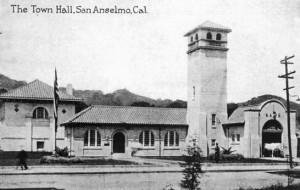
Town Hall, Fire Station, Library 1915. Colonel or Major stands in the doorway. Original square hip roof on the tower.
The tower, originally with a square hip roof, had five floors. Historical Commissioner Antone Sousa, son of former Fire Chief Frank Sousa, and retired Battalion Chief Marty Marcucci, son of former Fire Chief Nello Marcucci, have memories of the tower dating back to their childhoods and provided details of the original interior configuration.
The ground floor had a bathroom with a toilet in a closet. The second level was the kitchen with a small gas stove, cupboards and a window; hose was stored on the third; the fourth was used for storage; and the fifth held the bell and striking mechanism. The fire bell, from the McShane Foundry in Baltimore, Maryland, called the volunteer force to action.
A shaft ran from the ground floor of the tower to the fifth floor in which 50 foot lengths of hose were hung to dry. The hoses, heavy cotton with brass fittings, would rot if not properly dried. Using a rope and pulley system, the men on the fifth/bell floor would hoist the lengths of hose up and drop the butt ends into hangers where they hung until dry.
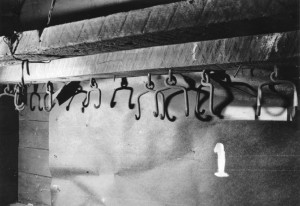
Hose hangers in the tower, 1978
In the mid-1930s, an antenna was placed on the backside of the tower for emergency radio communications. The antenna allowed the drivers of the two radio-equipped police cars and the fire chief’s automobile to converse with the operator in town hall. A short time later, the peak of the square hip roof was removed, and a 20-foot wooden support structure was constructed by Frank Sousa in order to raise the antenna. Antone recalls that his father was unafraid of heights and would climb the wooden structure each year to string Christmas lights.
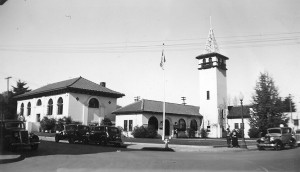
Wooden support structure on the tower, c. 1937
In October 1944, Chief Nello Marcucci was able to purchase and install on the roof a new air-powered horn, a Gamewell Diaphone, and connect it to the fire alarm system. These horns were installed at fire stations and public buildings all over the country.
According to the Gamewell Company literature, the horn was “characterized by great carrying power, distinctive tone, and the ability to sound coded signals in short and distinct blasts.” Longtime residents will recall that in addition to sounding the alert for a fire and the number of the alarm box reporting the incident, San Anselmo’s horn sent out three blasts at 8:00 a.m., noon, and 5:00 p.m. The diaphone, now 70 years old, is still in use, tested weekly on Fridays at noon with a single blast and sounds a warning (five blasts repeated three times) to seek higher ground when flooding of San Anselmo Creek is imminent. Marty Marcucci believes that the old fire bell was probably sold to someone for its metal content.
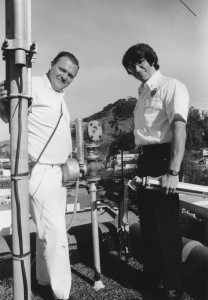
Richard Kientz with hand on antenna and Battalion Chief Marty Marcucci. Between them is the air horn with a three mile range.
The wooden antenna structure was removed by 1960, but the roof was not rebuilt. In 1978-79, the town hall complex underwent a major remodel. The fire department moved to its new quarters on San Anselmo Avenue, an administrative wing and the old fire station were demolished, and a new two-story building was constructed for the administrative offices. The stucco was removed from the tower and replaced, but again the roof wasn’t rebuilt.
Over the years, the tower was damaged by rain water and nesting birds. The recently completed project restored the square hip roof, and replaced damaged framing and balusters. In coordination with the Hungry Owl Project, a custom owl nesting box was installed with provisions for future installation of a live video streaming camera to monitor the nesting owls.
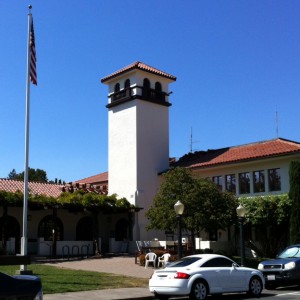
Restored tower roof, 2014

